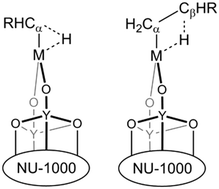The effects of active site and support on hydrogen elimination over transition-metal-functionalized yttria-decorated metal–organic frameworks†
Abstract
Hydrogen elimination from a metal alkyl complex and its reverse reaction are critical elementary steps in many catalytic cycles. In understanding such catalytic cycles, it is important to learn about the effect of the active site as well as effects beyond the active site, especially support effects. Here we employ density-functional-theory-based computational screening of transition-metal-functionalized yttria-decorated NU-1000 metal–organic frameworks to study the effect of metal sites and supports on the hydrogen elimination reactions. We consider six transition metals. The screening shows that a Nb-based catalyst has the lowest free energy of activation for both α-H elimination and β-H elimination, but for the latter we must also consider the free energy of release of the alkene. By the Sabatier principle, the optimal catalyst for β-H elimination is the one that interacts with molecules with intermediate strength for easy reactant activation as well as easy product desorption. By employing a volcano plot to find the optimum compromise, we identified V-functionalized, yttria-decorated NU-1000 as the most active catalyst among the trial candidates for the β-H elimination reaction. The analysis also reveals a support-specific charge transfer process in which the yttria and carboxylate linkers enable electron transfer between the transition-metal site and organic linkers of the NU-1000 simultaneously with a coordinated change of spin at the metal site and in the linker groups. Based on our analyses, we hypothesize that the observed charge transfer enables certain functional groups, such as propyl, to interact more strongly with the support and stabilize the catalyst.



 Please wait while we load your content...
Please wait while we load your content...
